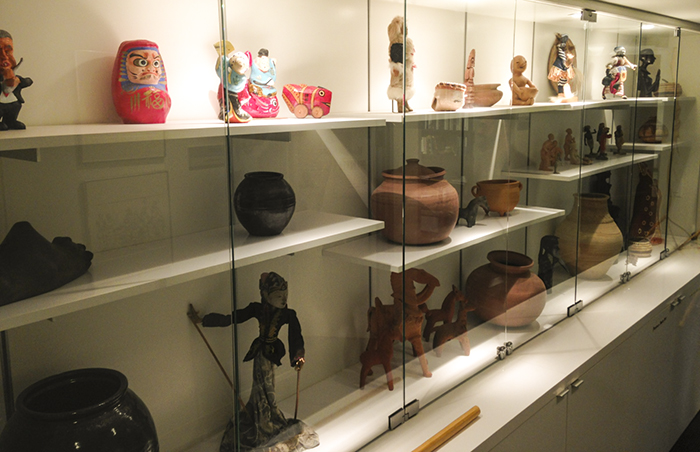Although we never set out to have a collection, the Center definitely has one now, with around eight hundred pieces acquired during fieldwork, donated by artists, or presented by delegations in appreciation of the experience they had at the Festival. Some pieces have even been commissioned.
Our unofficial “office collection” is currently displayed in hallway cases, the reception lobby, the conference room, and on office walls. While we do not have public gallery space, we do host many visitors who are often captivated by the charm and variety of what they see—and they want to know more.
Most of the knowledge about the pieces is in the memories of the staff and curators who work here. The Ralph Rinzler Folklife Archives and Collections holds related photographs, film, and interview transcripts, but much remains to be revealed by pulling this information together.
Because of the circumstances of their creation and gifting, the majority of the objects in the office are considered story emblems more than heirloom pieces, meaning they are valued especially for the stories they hold and can tell, and for the knowledge, skill, and traditional practices they embody.

A case in point is the nearly life-size logger and small dog that stand in the reception lobby as if to greet visitors. They are chainsaw-carved figures from the logging heritage of western Maine.
Their maker, Rodney Richard Sr., is a three-time Smithsonian Folklife Festival participant and co-founder of a logging museum in Rangeley, Maine.
Richard came to value the things he knows about life in the woods, in part because he saw the old-time knowledge slipping away as new machines and methods replaced the old. His figures often represent traditional practices, and, in this case, the logger rests against a peavey hook, which is a useful hand-tool for maneuvering felled trees.
He made the carved logger in 1983 while participating in the French and French-American program, and donated it to CFCH at the end of the Festival. When he returned in 2005 to participate in the Forest Service, Culture, and Community program, he carved the little dog to keep the logger company.
People visiting the office may recognize “logger art,” but without the story of Richard, his origins in Maine (and before him, his father’s French Canadian roots in New Brunswick), and the educational focus of his work, much cultural significance would be missed.
In the months ahead, I will continue documenting the collection and creating interpretive labels to help visitors and staff alike learn some of the stories these wonderful objects have to tell.
Erin Younger is a long-time museum professional who recently moved to Washington, D.C., from Seattle. She is currently working at CFCH as a research associate. Each week she uncovers at least one new story from an intriguing object, working with curator Marjorie Hunt to document the collection.


